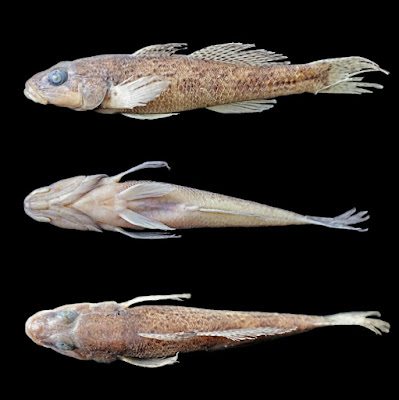[Most Recent Entries] [Calendar View]
Tuesday, July 9th, 2024
| Time | Event | ||
| 7:57a | [Ichthyology • 2024] Microdous hanlini • A New Species of the fine-toothed Sleepers (Gobiiformes: Odontobutidae) from Guangxi, China Abstract Microdous (Gobiiformes: Odontobutidae) is a genus of freshwater sleepers distributed in southern China and Vietnam. There are two described species in this genus, M. chalmersi widely distributed in Hainan Island and Guangxi province of China and M. amblyrhynchos with a very restricted distribution range in Baise, Guangxi. It has been reported that M. chalmersi of Guangxi might be a cryptic species, which is different from M. chalmersi of Hainan. Here, we describe the cryptic species from Guangxi as a new species, Microdous hanlini, and compare it with the other species of Microdous. Microdous hanlini can be distinguished from M. chalmersi by its wider head (head width/head length = 0.51–0.58 vs. 0.48–0.53 in M. chalmersi) and wider interorbital width (interorbital width/head length = 0.15–0.19 vs. 0.09–0.13 in M. chalmersi). Microdous hanlini can be distinguished from M. amblyrhynchos by its longer snout, (snout length/head length = 0.29–0.35 vs. 0.26–0.28 in M. amblyrhynchos); slenderer head (head width/head length = 0.51–0.58 vs. 0.61–0.65); and protruding eyes (vs. not protruding). Phylogenetics analyses based on partial sequence of cytochrome c oxidase subunit I (COI) gene (~1500 bp) showed that M. hanlini, M. chalmersi and M. amblyrhynchos formed reciprocal monophyletic clades and M. hanlini is more closely related to M. amblyrhynchos than to M. chalmersi. Genetic distance between the three species is greater than the interspecific distance between some species of Odontobutis. Key words: Odontobutidae, skin teeth, freshwater sleepers, taxonomy, cryptic species
Microdous hanlini Wang, He & Li, sp. nov. Diagnosis. The species M. hanlini can be distinguished from M. chalmersi (Nichols & Pope, 1927) by the following characteristics: wider head, head width/head length = 0.51–0.58 (vs. slender head, head width/ head length = 0.48–0.53); wider interorbital width, interorbital width (bone)/head length = 0.15–0.19 (vs. slender head and narrow interorbital width, interorbital width (bone)/head length = 0.09–0.13). The species can be distinguished from M. amblyrhynchos by the following characteristics: snout pointed, snout length/head length ratio 0.29–0.35 (vs. blunt snout, snout length/head length ratio 0.26–0.28); slenderer head, head width/ head length = 0.51–0.58, (vs. head width/head length =0.61–0.65); eye large and protruding outward (vs. eye not protruding) (Fig. 3, Table 1). The species M. hanlini can be distinguished from Sineleotris saccharae by absence of dark band under eye. The species M. hanlini can be distinguished from Sineleotris namxamensis by the following characteristics: lateral scale rows 40-43 (vs. 36-39); transverse scale rows 14-16 (vs. 12-14). These distinguishing features showed no difference between male and female individuals of M. hanlini (Table 2.) ... Etymology. The species name is named after Prof. Hanlin Wu in honor of his significant contributions to the study of the gobiiform fishes of China. Fangxin WANG, Mulan WEI, You HE and Chenhong LI. 2024. Microdous hanlini (Gobiiformes: Odontobutidae), A New Species of the fine-toothed Sleepers from Guangxi, China. Zootaxa. 5477(3); 367-379. DOI: doi.org/10.11646/zootaxa.5477.3.6 | ||
| 11:24a | [Botany • 2024] Aeschynanthus maoi (Gesneriaceae) • A New Species from Arunachal Pradesh, India
Abstract Aeschynanthus maoi, a new species of Gesneriaceae from Lower Dibang Valley of Arunachal Pradesh, India, is described and illustrated. It is morphologically similar to A. wardii and A. bracteatus, but differs from the former by its small (3–5 mm long) boat-like bracts, narrowly ovate or triangular calyx lobes, 1–8 flowered inflorescences, and turbinate staminodes. It differs from the latter by caducous green bracts, short peduncles (0.2–0.8 cm long), and narrowly ovate or triangular green calyx lobes. A detailed description of the new species with color photographs and a comparison to similar species are provided. The new species is evaluated for risk of extinction and provisionally assessed as Critically Endangered (CR) according to IUCN Red List Categories and Criteria. Keywords: Aeschynanthus wardii, lipstick plant, Lower Dibang Valley, northeast India, sect. Haplotrichium Manas Ranjan Debta, Akshath Shenoy, Mannar Kandy Akhil and Santhosh Nampy. 2024. Aeschynanthus maoi, A New Species of Gesneriaceae from Arunachal Pradesh, India. Brittonia. DOI: 10.1007/s12228-024-09790-2 | ||
| 3:47p | [Herpetology • 2024] Uropeltis caudomaculata • A New Species of Uropeltis Cuvier, 1829 (Serpentes: Uropeltidae) from the eastern escarpment of the southern Western Ghats, India
Abstract A new species of the uropeltid (‘shieldtail’) snake genus Uropeltis is described based on eight specimens from the southern part of peninsular India’s Western Ghats. Uropeltis caudomaculata sp. nov. is phenotypically and genetically most similar to U. pulneyensis (Beddome, 1863), but differs primarily in having more ventral scales and in being restricted to the eastern escarpment of the Western Ghats between Meghamalai and approximately 15 km East of Munnar rather than in the Palani Hills, as well as differing in DNA nucleotide sequences. From verified records, we consider U. pulneyensis to be known thus far only from the Palani Hills, and we designate a lectotype for the species. Reconsideration of the holotype of Silybura guentheri Beddome, 1878 from Meghamalai leads us to conclude that it should be removed from the subjective junior synonymy of U. pulneyensis and be considered a distinct though very poorly known species, Uropeltis guentheri comb. nov. Reptilia, shieldtail, snake, Silybura guentheri, taxonomy, Uropeltis pulneyensis Uropeltis caudomaculata sp. nov. David J. Gower, Sandeep Das, V. Deepak, Jason D. Gerard and Surya Narayanan. 2024. A New Species of Uropeltis Cuvier, 1829 (Serpentes: Uropeltidae) from the eastern escarpment of the southern Western Ghats, India. Zootaxa. 5477(3); 333-357. DOI: doi.org/10.11646/zootaxa.5477.3.4 |
| << Previous Day |
2024/07/09 [Calendar] |
Next Day >> |







